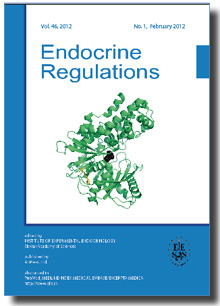Journal info
|
||
Select Journal
Journals
Bratislava Medical Journal Ekologia - Ecology Endocrine Regulations 2015 2014 2013 2012 2011 2010 2009 2008 2007 2006 2005 2004 2003 General Physiology and Biophysics Neoplasma Acta Virologica Studia Psychologica Cardiology Letters Psychológia a patopsych. dieťaťa Kovove Materialy-Metallic Materials Slovenská hudba 2025Webshop Cart
Your Cart is currently empty.
Info: Your browser does not accept cookies. To put products into your cart and purchase them you need to enable cookies.
Endocrine Regulations Vol.46, No.4, p.205–215, 2012 |
||
| Title: Modified endogenous carbon monoxide production through modulation of heme oxygenase activity alters some aspects of the cold restraint stress response in male albino rats | ||
| Author: S. El-Sayed, M. Hassan, M. Ibrahim, E. Elbassuoni, N. Aziz | ||
| Abstract: Objective. Multiple stimulatory and inhibitory inputs regulate the hypothalamic-pituitary-adrenal axis (HPA). Although the results of the previous studies are contradictory, it has been indicated that the carbon monoxide (CO) may play a role in the HPA regulation. The aim of the present study was to investigate the effect of modified endogenous CO production on some aspects of the cold restraint stress (CRS) response in adult male albino rats. Methods. Modification of the endogenous CO was performed by altering the heme oxygenase (HO) activity; its induction was achieved by administration of the hemin (HEM) and inhibition by administration of the zinc mesoporphyrin (ZM). Results. We found that in both the non-stressed and stressed groups the HEM significantly decreased the plasma levels of epinephrine (EPI), adrenocorticotropic hormone (ACTH), corticosterone (B), cholesterol, triglycerides, high-density lipoprotein cholesterol (HDL-C), and low-density lipoprotein cholesterol (LDL-C). On the other hand, ZM significantly increased the adrenal EPI, norepinephrine (NE), dopamine (DA), and the plasma levels of EPI, NE, DA, ACTH, B, cholesterol, triglycerides, HDL-C, and LDL-C, as compared with control and stressed rats. Conclusion. The role of CO reaction to the CRS response could be clarified as an anti-stress effect. This is evidenced by the inhibitory effect of HO inducer, HEM, on the HPA axis and a consequent less hazardous metabolic profile which it produced. |
||
| Keywords: carbon monoxide, hemin, heme oxygenase, stress | ||
| Year: 2012, Volume: 46, Issue: 4 | Page From: 205, Page To: 215 | |
| doi:10.4149/endo_2012_04_205 |
||
|
Price:
22.00 €
|
||
|
|
||

